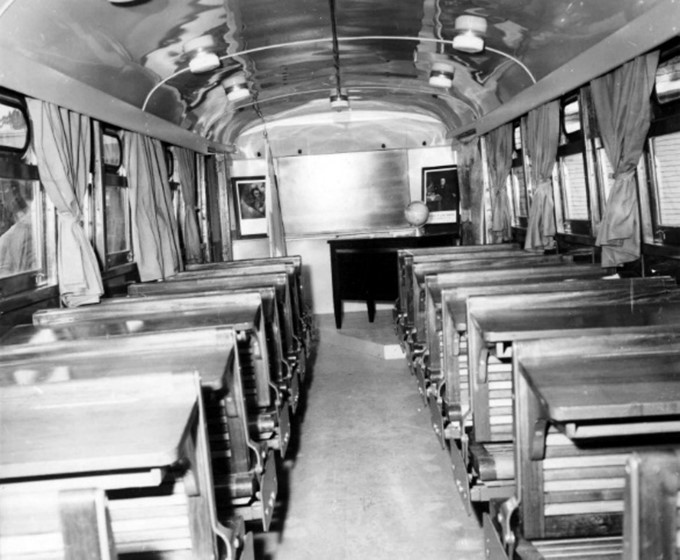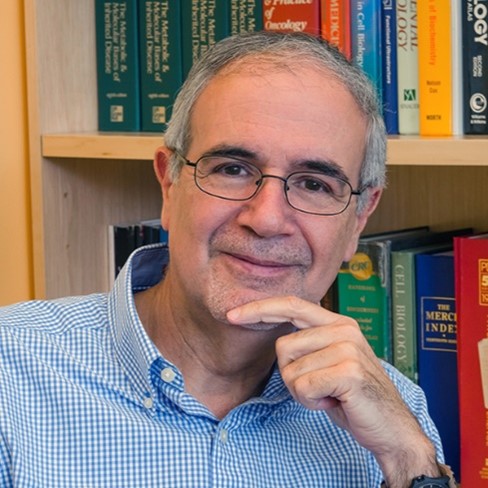How did you first become interested in science?
Sometimes, children will say, “I want to be a scientist when I grow up,” and in my case, I really meant it. My parents noticed my early interest in science and, despite only having an elementary school education themselves, they nurtured my love for learning and knowledge.

Credit: General Archive of the Nation Argentina (Archivo General de la Nación Argentina), AR-AGN-AGN01-AGAS-Ddf-rg-1059-275174
I also benefited from the public education system in my native Argentina, and from an early age, I always tried to take the best from any situation I was in. For example, my elementary school didn’t even have its own building. It functioned first in a church, then in a neighborhood association, and then finally, on its own land. But the classrooms were converted trolleys—they refurbished street trolleys and turned them into classrooms. While this could be seen as a significant limitation, I had fantastic teachers who recognized my interest in science and fueled my curiosity, often by providing me with advanced books in biology, chemistry, and physics.
Can you share how your experiences in Argentina were instrumental in shaping your career today?
The awarding of the 1970 Nobel Prize in Chemistry to Dr. Luis F. Leloir for his discovery of sugar nucleotides and their role in the biosynthesis of polysaccharides demonstrated that groundbreaking science could be achieved in developing countries like Argentina. Through his achievements, he became a role model for many aspiring researchers, including myself. My own doctoral advisor, Dr. Alejandro C. Paladini, had been a postdoctoral fellow in Dr. Leloir’s lab and had contributed to the research that led to the Nobel Prize.
When it came time to choose a career, I faced a dilemma between chemistry, physics, biology, and medicine. Ultimately, I chose biochemistry because it combined elements of all these disciplines. During my formative years at the University of Buenos Aires, two review articles shaped my future interests: one about the fluid mosaic model describing the structure of cell membranes and one discussing receptor-mediated endocytosis. These papers inspired my lifelong pursuit of understanding membrane protein properties. Over the years, I’ve been fortunate to have had many exceptional mentors who supported me in realizing my childhood dream of becoming a scientist.
What factors contributed to your decision to move to the United States and train at NIH?
 After earning my doctorate in biochemistry from the University of Buenos Aires, I had a keen interest in continuing my research career. The next logical step was to pursue postdoctoral training at a leading institution abroad. For me, that institution was NIH, which I joined in 1982 and where I have been ever since.
After earning my doctorate in biochemistry from the University of Buenos Aires, I had a keen interest in continuing my research career. The next logical step was to pursue postdoctoral training at a leading institution abroad. For me, that institution was NIH, which I joined in 1982 and where I have been ever since.
NIH has been everything I hoped for and more. It has provided the ideal environment for realizing my goal of conducting top-tier research. Key factors include my exceptional colleagues, the collaborative interactions with both basic and clinical investigators, the atmosphere of intellectual freedom, and the stable funding. Additionally, I appreciate having the opportunity to serve the public by contributing to research that benefits society.
What traits are essential for success as an independent researcher?
The most important trait for success in science is a passion for knowledge and discovery. This passion enables you to overcome the challenges that come with venturing into the unknown. It’s also important to choose significant questions and problems to investigate. Furthermore, it’s essential to have mentors who will guide and support you throughout your career. I have been fortunate to have mentors like Drs. Rick Klausner, a new NICHD principal investigator when I joined, and Art Levine, NICHD’s Scientific Director at the time, who trusted in me even more than I did myself.
What advice do you have for people who are at earlier career stages?
I advise new principal investigators to address an important scientific question and apply all their talents to finding an answer. Persevere in the face of challenges and failures and have faith in yourself. When things are not going well, remind yourself of past successes. When you begin to have self-doubt, tell yourself, “You’ve done it before, and you’ll do it again.”
Over your four decades in research, can you share one of your favorite findings?
One of the most thrilling discoveries in our lab occurred in 1994 when Dr. Hiroshi Ohno, then a postdoctoral fellow and now a team leader at RIKEN in Japan , identified the proteins responsible for decoding signals that sort transmembrane proteins to endosomes and related compartments.
Hiroshi conducted a screen using a sorting signal as bait and isolated several interacting clones. I remember us huddling in front of a computer terminal, eagerly searching for the sequence of these clones in the GenBank database. We were exhilarated to find that one of the clones encoded a subunit of the clathrin-associated AP-2 complex, which had been hypothesized, but not yet proven, to be involved in signal recognition. This discovery marked the beginning of our lab’s focus on the mechanisms of intracellular protein sorting.
While there have been many other exciting moments in my career, this one stands out as particularly memorable because it occurred at the outset of my tenure-track position at NIH, when my lab was still small. Additionally, some colleagues had questioned our chances of success with this project, especially because more established labs had previously struggled with it.
What do you enjoy the most at this stage of your career?
I feel blessed to continue leading a research group at NIH after all these years. My team of about 10 researchers is dedicated to studying various aspects of intracellular protein and organelle transport and the relevance of these mechanisms to neurodevelopmental diseases. These young, bright, and kind individuals come from the United States and other countries around the world, and they all work harmoniously to advance knowledge and make discoveries for the common good. Every day, I get up grateful to be working with such a remarkable group of people. I also value having friends and colleagues all over the world. The international nature of the scientific enterprise shows that cooperation among nations is possible when there is a common goal of helping humanity by advancing knowledge and solving global challenges.
What is special about working at NICHD?
I felt welcome from the very beginning because NIH has always had leadership that recognizes the importance of diversity. NICHD, in particular, has a beautiful mission of helping groups that have been marginalized, such as people with disabilities.
I had the opportunity to meet Eunice Kennedy Shriver during the 40th anniversary of the founding of NICHD. She had a party at her house and had invited all the leadership, including branch and lab chiefs. When my wife and I arrived, Eunice was standing in front of her house, warmly greeting everybody at the party. She asked us where we were originally from. When we said “Argentina,” she replied that she had just returned from Buenos Aires, where she had been promoting the Special Olympics, an institution she had founded. I thought she was extremely gracious, and it was a special honor for me to meet such a wonderful champion for people with disabilities.
Over the years, I’ve been offered prominent positions at prestigious universities, but I have consistently chosen to remain at NIH. When weighing these opportunities, my primary consideration was not where I would have greater prominence or a higher salary, but where I would be happier. The answer has always been NIH.
Return to Get to Know NICHD.
 BACK TO TOP
BACK TO TOP